


 
 
 
 Photo Essay: Walking on Thick IceFirst posted in August, 2000 Photo Essay: Walking on Thick IceFirst posted in August, 2000
| I've spent quite a bit of time this summer acquainting myself with the backcountry of Wrangell-St. Elias National Park and Preserve, where I am fortunate enough to be working this summer as a historical archaeologist. The park is located in south-central Alaska. It is the largest park in the National Park System, with over thirteen million acres (roughly the size of the state of West Virginia), so there's a lot of backcountry to become acquainted with. I couldn't possibly hope to see but a fraction of it this summer, but I've been doing my best to try. | 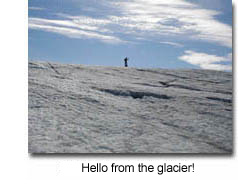 |
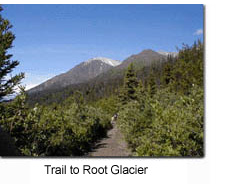 I'd like to share with you the story of a pleasant two-hour stroll to the Root Glacier that I took with some friends after work one evening this past July while working at Kennecott National Historic Landmark in the heart of Wrangell-St. Elias.
From Kennecott, the Root Glacier is a mere half-hour stroll over gently rolling terrain. The trail begins in a pleasant forest of white spruce, willow and alder, and large bolders are present along the trail. Due to its ease of travel and scenic destination, the trail is perhaps one of the most heavily used in the Kennecott area... but on this particular day I was not looking for solitude. Rather, I was enjoying the company of my friends and the new (to me) experience of walking on a glacier. I was very excited. I'd like to share with you the story of a pleasant two-hour stroll to the Root Glacier that I took with some friends after work one evening this past July while working at Kennecott National Historic Landmark in the heart of Wrangell-St. Elias.
From Kennecott, the Root Glacier is a mere half-hour stroll over gently rolling terrain. The trail begins in a pleasant forest of white spruce, willow and alder, and large bolders are present along the trail. Due to its ease of travel and scenic destination, the trail is perhaps one of the most heavily used in the Kennecott area... but on this particular day I was not looking for solitude. Rather, I was enjoying the company of my friends and the new (to me) experience of walking on a glacier. I was very excited.
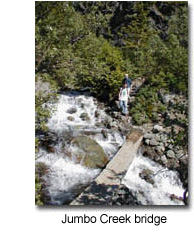 The trail continues just below the treeline, with Bonanza Ridge towering on the right and the glacier dancing in and out of view on the left. The roaring sound of Jumbo Creek in the distance worried me a bit. The waters are glacially fed and extremely cold - not that I mind getting a little wet, but I hadn't really planned on it this particular afternoon. As it turned out though, there's a nice little footbridge that makes crossing Jumbo Creek a breeze.
On the far side of Jumbo Creek, the trail begins to dip down out of the trees, closer and closer to the rocky lower portions of the glacier. The terrain becomes a bit steeper, but a fairly solid path makes for easy walking on what would otherwise be considered ankle-rolling terrain. We made our descent down across the glacier's lateral moraine, a rocky area composed of material deposited by the glacier during previous advances when it took up more of the mountainside, and finally found ourselves at the edge of the ice.
There was a tiny little crevasse to jump across to actually get onto the glacier. The crevasse wasn't wide, nor deep, but I was in hiking boots and the other side of the crevasse was ice. It looked like I was probably going to take a spill on the other side, and I wasn't sure what to do. My friends, who had hiked on this glacier before, hopped across in their hiking boots without a second thought as I stood by, preparing myself for what I was hoping would be a graceful-looking tumble (those of you reading this that have walked on the lower stretches of a glacier before are probably chuckling). The trail continues just below the treeline, with Bonanza Ridge towering on the right and the glacier dancing in and out of view on the left. The roaring sound of Jumbo Creek in the distance worried me a bit. The waters are glacially fed and extremely cold - not that I mind getting a little wet, but I hadn't really planned on it this particular afternoon. As it turned out though, there's a nice little footbridge that makes crossing Jumbo Creek a breeze.
On the far side of Jumbo Creek, the trail begins to dip down out of the trees, closer and closer to the rocky lower portions of the glacier. The terrain becomes a bit steeper, but a fairly solid path makes for easy walking on what would otherwise be considered ankle-rolling terrain. We made our descent down across the glacier's lateral moraine, a rocky area composed of material deposited by the glacier during previous advances when it took up more of the mountainside, and finally found ourselves at the edge of the ice.
There was a tiny little crevasse to jump across to actually get onto the glacier. The crevasse wasn't wide, nor deep, but I was in hiking boots and the other side of the crevasse was ice. It looked like I was probably going to take a spill on the other side, and I wasn't sure what to do. My friends, who had hiked on this glacier before, hopped across in their hiking boots without a second thought as I stood by, preparing myself for what I was hoping would be a graceful-looking tumble (those of you reading this that have walked on the lower stretches of a glacier before are probably chuckling).
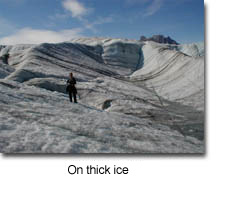 This hike had been arranged in a spur-of-the-moment manner. My friends had just peeked their heads into the town's Machine Shop, where I was curating artifacts and about to call it a day, and asked if I'd like to join them. Needless to say, I didn't have much with me in the way of mountaineering gear. This was my first walk on a glacier. I've never even worn crampons or tried out an ice axe. What I discovered upon jumping the crevasse (after much coaxing from friends) was that the lower sections of the Root Glacier are very dirty and gritty. That dirt, coupled with the relatively warm summer temperatures (it was about 80F outside this particular day and very sunny) makes the ice slushy and gritty and pretty easy to walk on in hiking boots.
With my new found confidence, I made my way up the glacier, past a small but powerful glacially-fed stream. It's amazing how the water reshapes the ice, running along the surface for a stretch, then carving out a vertical hole and plunging through it into a subsurface channel. The landscape is constantly changing, and a waterfall present today might not be here next year. This hike had been arranged in a spur-of-the-moment manner. My friends had just peeked their heads into the town's Machine Shop, where I was curating artifacts and about to call it a day, and asked if I'd like to join them. Needless to say, I didn't have much with me in the way of mountaineering gear. This was my first walk on a glacier. I've never even worn crampons or tried out an ice axe. What I discovered upon jumping the crevasse (after much coaxing from friends) was that the lower sections of the Root Glacier are very dirty and gritty. That dirt, coupled with the relatively warm summer temperatures (it was about 80F outside this particular day and very sunny) makes the ice slushy and gritty and pretty easy to walk on in hiking boots.
With my new found confidence, I made my way up the glacier, past a small but powerful glacially-fed stream. It's amazing how the water reshapes the ice, running along the surface for a stretch, then carving out a vertical hole and plunging through it into a subsurface channel. The landscape is constantly changing, and a waterfall present today might not be here next year.
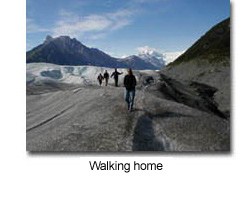 Some of the more experienced folks in our group went on to the icier parts of the glacier. I was content to remain behind with a couple of the folks who didn't have very decent tread on their shoes. It was enough for me, this trip, to stay low and just take it all in. We found some comfortable little boulders to sit on near a tiny stream of water and enjoyed the view. The copper mines that once supported the historic mining town of Kennecott were visible a few thousand feet up Bonanza Ridge, as were the tramlines that once transported copper ore from the mines to the mill. I spent the next few minutes contemplating how man and the glaciers have continually reworked the shape of this valley.
After an hour or so of exploring and playing on the glacier, we decided to head back for supper. I had an excellent time. Though the glaciers near my home in Yakutat, Alaska are not nearly as easy to access as the Root Glacier, I hope to try and explore them a bit once I get home. Very few of us have glaciers in our backyard, but if you are one of the lucky folks who have one, and you haven't been to check it out, you should make time to do so very soon. Some of the more experienced folks in our group went on to the icier parts of the glacier. I was content to remain behind with a couple of the folks who didn't have very decent tread on their shoes. It was enough for me, this trip, to stay low and just take it all in. We found some comfortable little boulders to sit on near a tiny stream of water and enjoyed the view. The copper mines that once supported the historic mining town of Kennecott were visible a few thousand feet up Bonanza Ridge, as were the tramlines that once transported copper ore from the mines to the mill. I spent the next few minutes contemplating how man and the glaciers have continually reworked the shape of this valley.
After an hour or so of exploring and playing on the glacier, we decided to head back for supper. I had an excellent time. Though the glaciers near my home in Yakutat, Alaska are not nearly as easy to access as the Root Glacier, I hope to try and explore them a bit once I get home. Very few of us have glaciers in our backyard, but if you are one of the lucky folks who have one, and you haven't been to check it out, you should make time to do so very soon.
[ TOP OF THIS PAGE | MORE PHOTOGRAPHY | MORE WRITING | HOME ]


|









